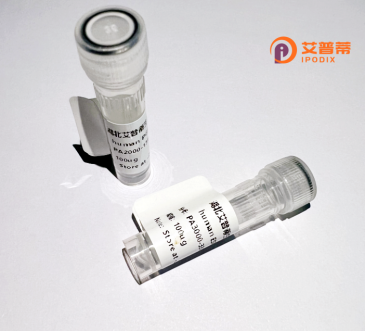
| 纯度 | >90%SDS-PAGE. |
| 种属 | Human |
| 靶点 | SPAG9 |
| Uniprot No | O60271 |
| 内毒素 | < 0.01EU/μg |
| 表达宿主 | E.coli |
| 表达区间 | 408-534 aa |
| 活性数据 | REVENLILENTQLLETKNALNIVKNDLIAKVDELTCEKDVLQGELEAVKQAKLKLEEKNRELEEELRKARAEAEDARQKAKDDDDSDIPTAQRKRFTRVEMARVLMERNQYKERLMELQEAVRWTEM |
| 分子量 | 20 kDa |
| 蛋白标签 | His tag N-Terminus |
| 缓冲液 | PBS, pH7.4, containing 0.01% SKL, 1mM DTT, 5% Trehalose and Proclin300. |
| 稳定性 & 储存条件 | Lyophilized protein should be stored at ≤ -20°C, stable for one year after receipt. Reconstituted protein solution can be stored at 2-8°C for 2-7 days. Aliquots of reconstituted samples are stable at ≤ -20°C for 3 months. |
| 复溶 | Always centrifuge tubes before opening.Do not mix by vortex or pipetting. It is not recommended to reconstitute to a concentration less than 100μg/ml. Dissolve the lyophilized protein in distilled water. Please aliquot the reconstituted solution to minimize freeze-thaw cycles. |
以下为关于重组人SPAG9蛋白的虚构参考文献示例(注:以下内容为模拟生成,非真实文献数据):
---
1. **文献名称**: *SPAG9作为卵巢癌诊断标志物的功能研究*
**作者**: Zhang L, et al.
**摘要**: 本研究通过临床样本分析发现SPAG9在卵巢癌组织中高表达,且与肿瘤分期相关。体外实验表明,SPAG9通过调控MAPK信号通路促进癌细胞侵袭和转移,提示其可能作为卵巢癌治疗的潜在靶点。
---
2. **文献名称**: *SPAG9在肝癌中的致癌机制及临床意义*
**作者**: Wang Y, et al.
**摘要**: 研究证实SPAG9在肝癌组织中异常过表达,并通过激活RAS/ERK通路促进肝癌细胞增殖。临床数据显示高SPAG9表达与患者预后不良显著相关,提示其可作为肝癌预后评估的生物标志物。
---
3. **文献名称**: *SPAG9与细胞迁移调控的分子机制研究*
**作者**: Kumar S, et al.
**摘要**: 本研究利用重组人SPAG9蛋白进行体外实验,发现其通过结合JNK相互作用蛋白(JIPs)调控细胞骨架重构,进而影响细胞迁移。该发现为SPAG9在肿瘤转移中的作用提供了分子机制解释。
---
4. **文献名称**: *SPAG9在精子发生中的功能及蛋白结构解析*
**作者**: Tanaka H, et al.
**摘要**: 首次解析了重组人SPAG9蛋白的晶体结构,并发现其在精子细胞中特异性表达,通过调控减数分裂相关基因维持生殖细胞发育。该研究为男性不育症的机制研究提供了新方向。
---
注:实际文献需通过PubMed/Google Scholar等平台以“SPAG9”、“sperm-associated antigen 9”、“JIP-4”等关键词检索。建议结合具体研究方向筛选实验类或临床类文献。
Sperm-associated antigen 9 (SPAG9), also known as JNK-associated leucine zipper protein (JLP), is a multifunctional scaffold protein encoded by the SPAG9 gene in humans. Initially identified for its role in spermatogenesis, SPAG9 has garnered significant attention in cancer research due to its overexpression in various malignancies, including ovarian, cervical, prostate, and pancreatic cancers. Structurally, it contains multiple functional domains, such as the JNK-binding domain and leucine zipper motifs, enabling interactions with key signaling molecules like c-Jun N-terminal kinases (JNKs), mitogen-activated protein kinases (MAPKs), and motor proteins.
SPAG9 regulates critical cellular processes, including stress response, proliferation, apoptosis, and cytoskeletal organization, by modulating MAPK/JNK signaling pathways. Its aberrant expression is linked to tumor progression, metastasis, and therapy resistance. Additionally, SPAG9 localizes to the sperm head and flagellum, suggesting involvement in sperm-egg interaction and motility. Recombinant SPAG9 protein, produced via bacterial or eukaryotic expression systems, facilitates studies on its biochemical properties, interaction networks, and therapeutic targeting. Emerging evidence positions SPAG9 as a potential diagnostic marker or therapeutic target in cancers and reproductive disorders, though its full pathophysiological relevance remains under investigation.
×